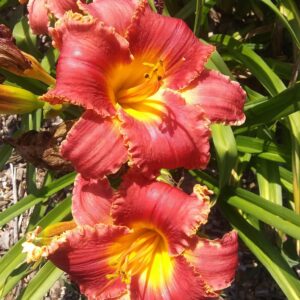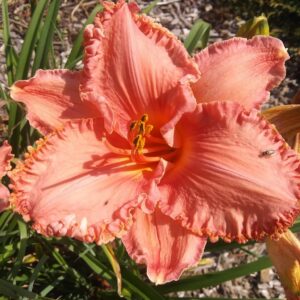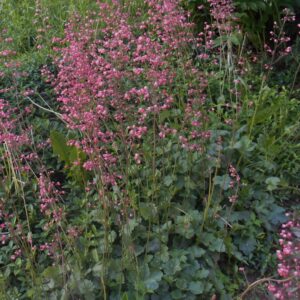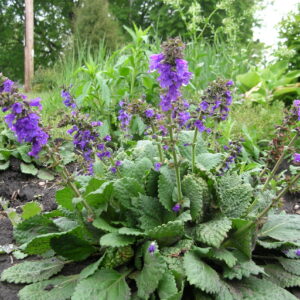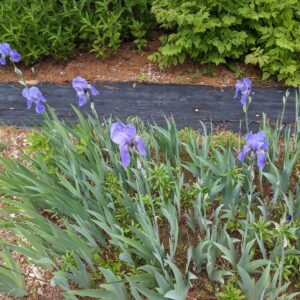"New" Heirloom Plants
Showing 25–32 of 62 results
-
Hemerocallis ‘Pretty Woman’
Ruffled edges frame its broad, recurved medium pink-purple petals that surround a sunshine throat.
Tetraploid daylily. Our own hybrid. It flowers in July.
Ruffled edges frame its broad, recurved medium pink-purple petals that surround a sunshine throat.Size: 20-30" tall
Care: Full sunOur own hybrid
-
Hemerocallis ‘Tangerine Dreams’
Profuse blooms. Ruffled edges frame its broad, recurved, vibrant tangerine-peachy petals with a stop-light yellow throat.
Tetraploid daylily. Our own hybrid. Flowers in July.
Profuse blooms. Ruffled edges frame its broad, recurved, vibrant tangerine-peachy petals with a stop-light yellow throat.Size: 20-30" tall
Care: Full sunOur own hybrid
-
Heuchera x brixoides ‘Caldwell’ Z 4-8
Small pink bells surround top 6” of the wiry, erect stems in late spring-mid-early-summer.
Small pink bells surround top 6” of the wiry, erect stems in late spring-mid-early-summer.
Size: 12-18” x 6-8”
Care: part shade in moist to moist well-drained soilI do not know which Heuchera this is. This was growing here when we moved here around 1995. We bought the property from spry 93-year-old Anne Patterson, “for sale by owner.” I cannot imagine that she was buying new plants in her 90’s so I’m making an educated guess that it is at least 40 years old. It does not set seed, not unusual for a hybrid. But we like it so much that we’ve divided it several times over the last couple of years to make enough to sell. Try as I might, I cannot identify it but I’ve narrowed it down to a hybrid called brixoides, of which there are innumerable different selections. I’ve named it ‘Caldwell” for the crossroads where our nursery is located, originally named for the 1st settlers, Joseph and Sara Caldwell c. 1860.
-
Horminum pyrenaicum Dragonmouth, Pyrenean Dead-nettle Z 5-9
Deep purple salvia-like blooms in April to May above rosettes of wide, flat leaves
Deep purple salvia-like blooms late spring to early summer above rosettes of wide, flat leaves
Size: 8-16” x 12”
Care: Sun to part shade in moist well-drained soil. Drought tolerant.
Native: Pyrenees & Alps
Wildlife Value: Attracts bees, butterflies and birds. Deer and rabbit resistant.Before 1753, Linnaeus.
-
Hosta ‘fortunei ‘Aureomarginata’ Z 3-9
One of the most popular Hosta varieties. Handsome, broad, ribbed, wavy, green foliage with yellow margins. Lavender, trumpet-shaped flowers rise on scapes above the leaves in summer.
One of the most popular Hosta varieties. Handsome, broad, ribbed, wavy, green foliage with yellow margins. Lavender, trumpet-shaped flowers rise on scapes above the leaves in summer.
Size: 12-16” x 18-24”
Care: shade to part-shade in moist well-drained soil. Tolerant Black walnut toxinsHosta named for Austrian botanist Nicholas Thomas Host (1761-1834) in 1812. This variety registered in 1987.
-
Iris ‘Spark’ Z 4-8
Early blooming, intermediate bearded iris of brick-red standards and burgundy falls with a bright spark of a beard in the middle.
Early blooming, intermediate bearded iris of brick-red standards and burgundy falls with a bright spark of a beard in the middle.
Size: 23” x 12”
Care: sun in moist well-drained soil.
Wildlife Value: Welcomes bees with easy access to pollen.Iris is named after the Greek goddess who accompanied the souls of women to the Elysian Fields by way of the rainbow. Her footprints left flowers the colors of the rainbow. Iris means the eye of heaven. The iris is the flower of chivalry, having “a sword for its leaf and a lily for its heart.” Ruskin. Spark hybridized and introduced by Col. J. C. Nicholls in 1931,
-
Iris pallida Grape iris Z 3-8
Blooms smell exactly like sweet grape soda - violet blue bearded iris in spring
Blooms smell exactly like sweet grape soda – violet blue bearded iris in spring
Size: 10-14” x 8-12”
Care: sun to part shade in moist well-drained soil. In July-August lift & divide every 2 to 3 years; discard mushy rhizomes.
Native: Europe
Size: Dried rhizomes used as a fixative to preserve fragrances in powders, perfume and gin.English herbalist John Gerard (1549-1612) called it “the great Floure de-luce of Dalmatia” and praising its “exceedingly sweet” scent, 1597. Grape soda had yet to be created!
-
Iris pumila Dwarf iris Z4-8
Natural hybrid created this tiny, purple bearded iris blooming in early spring bearing year-long green-grey sword-shaped leaves. Spreads to form large, tight clumps.
Natural hybrid created this tiny, purple bearded iris blooming in early spring bearing year-long green-grey sword-shaped leaves. Spreads to form large, tight clumps.
Size: 6-8” x spreading.
Care: sun in well-drained to moist well-drained soil
Native: Eastern Europe
Wildlife Value: deer resistantIn gardens before 1753

